Castillo de Gibralfaro & Alcazaba de Málaga, Spain
My blog lags behind my travel adventures, so it's high time to catch up. Let me take you to Málaga, the second-largest city in the Spanish region of Andalusia. It attracts crowds of tourists, making the off-season, like March, the ideal time to explore. That's when my girlfriend and I found ourselves there. The cold-resistants can dip in the sea in March, but it wasn't the main attraction this time. We wanted to soak in the Spanish vibes, as I have a soft spot for the country. And to climb up to the Castillo de Gibralfaro, a massive fortress above the city. It's quite a hike from sea level, and you have to hope the gatekeepers will let you through. They certainly look hardhearted!
I letos víc cestuju než o tom píšu. Už mám vyhlédnutou další letenku na květen, a tak je čas trochu srovnat skóre. Takže se přenesme do Málagy, druhého největšího města Andalusie. V létě bývá plné turistů, a tak je třeba takový březen na návštěvu ideální. Když jste trochu otužilí, můžete se vykoupat v moři, ale to tentokrát nebylo to hlavní lákadlo. I když lyže a moře v jednom měsíci... No, o tom už jsem psal. Španělsko je krásná země, je mi tam fajn. A protože jsem tam byl naposledy na Silvestra, březnový výlet byl tak nějak nasnadě. Jednou z dominant Málagy je pevnost Castillo de Gibralfaro, na kterou vás dnes vezmu. Od moře je to docela krpál, a navíc musíte doufat, že vás stráž pustí dovnitř. Podívejte, jak nelítostně se tváří!

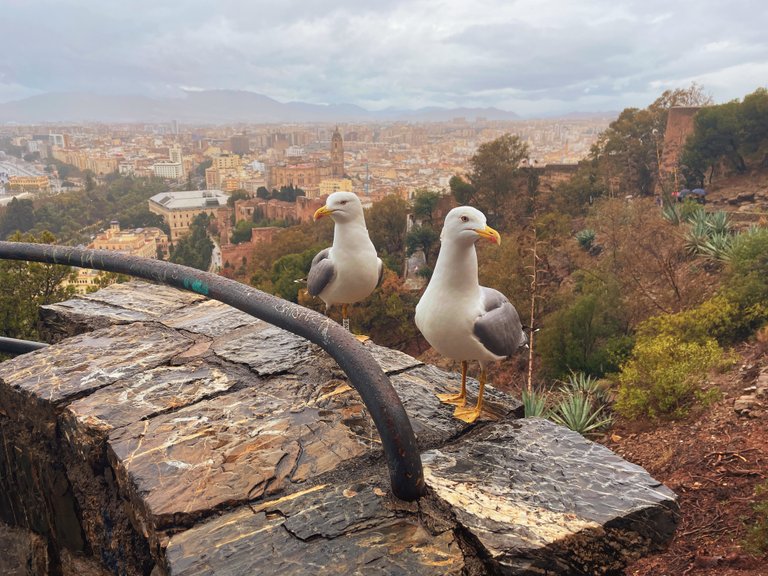
Anyway, let's start our journey in the city, at sea level. Unfortunately, luck wasn't on our side weather-wise that day. Andalusia is typically sunny and dry, but every now and then, a heavy rainstorm sweeps through, causing rivers to swell. Thankfully, this wasn't the case; it didn't rain cats and dogs. The rain felt like a pleasantly mild seaside shower, albeit one that persisted throughout most of the day. Even cows sought shelter under umbrellas.
Ale začněme ve městě, na úrovni moře. Počasí nám tentokrát moc nepřálo. I kdy je Andalusie většinou slunná a velkou část roku i vyprahlá, jednou za čas přijde průtrž mračen, která rozvodní napůl vyschlé řeky. Taková nás naštěstí nepotkala, byl to spíš takový ten klasický přímořský deštík, ale trval skoro celý den. A tak se i krávy raději schovávaly pod deštníkem.

The Gibralfaro hill above the city likely derives its name from an ancient Phoenician lighthouse (el faro in Spanish; pharus in Latin) – the Phoenician settlement of Málaka or Malake dates back to the 8th century BC. A millennium later, in the 10th century, the lighthouse was replaced with a fortress to oversee the Guadalmedina River and the merchant sea routes passing by Málaga. Its purpose was to protect the city, which had gained significance after the Moorish invasion of the Iberian Peninsula. The fortress was expanded and converted into a stronghold by the Nasrid emir Yusuf I in 1340. Towards the end of the Reconquista, the Castillo de Gibralfaro was besieged and captured by the Catholic Monarchs in 1487. I can't imagine storming the fortress since climbing the slippery path was no fun.
Kopec Gibralfaro se pravděpodobně jmenuje po majáku, který na něm vystavěli Féničané (španělsku se maják řekne el faro a latinsky pharus). Jejich kolonie jménem Málaka nebo Malake tu prokazatelně byla už od 8. století před Kristem. O nějakých tisíc let později, v desátém století, maják nahradila tvrz. Ta byla za vlády Jusúfa I. v roce 1340 rozšířena na pevnost. Tu pak na sklonku reconquisty, v roce 1487, dobyla Katolická veličenstva. Obléhat tuhle pevnost bych tedy nechtěl, ani obyčejná cesta nahoru po kluzké dlažbě nebyla žádná procházka růžovou zahradou.


At least we could feast our eyes on the city panorama with a famous bullring.
Cestou se alespoň můžete pokochat výhledy na město, vidět je i známá býčí aréna.
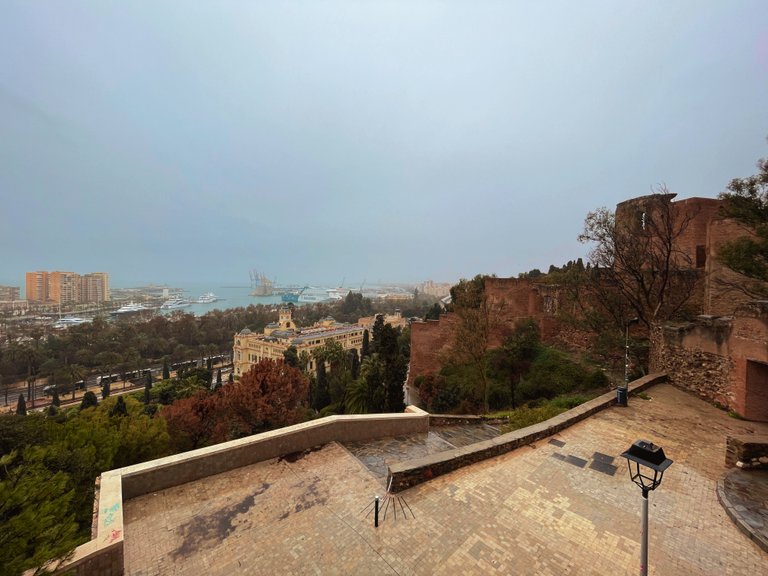

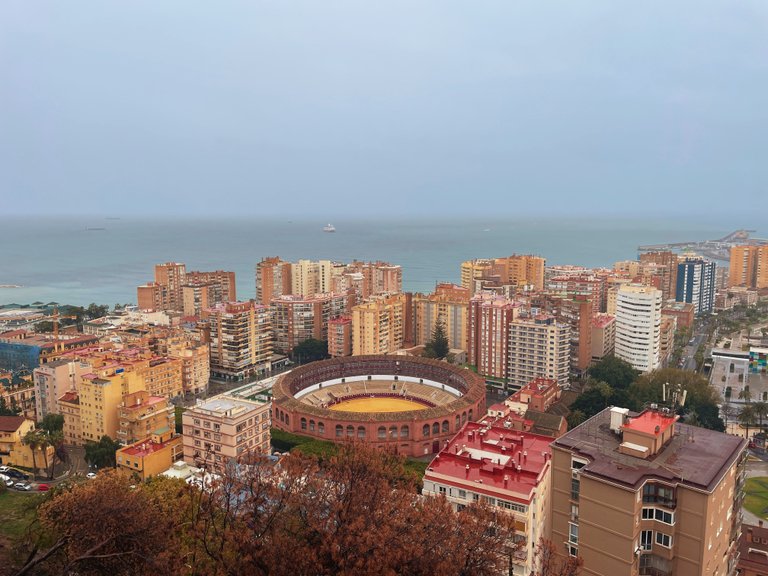
The Castillo de Gibralfaro was only a fortress with barracks and stables; the former emir's palace, later serving as the governor's residence, is lower down the hill. The fortification walls and towers have been well preserved over time, offering great views of Málaga. Although it's said that one can see the Rif mountain range in Africa or the Rock of Gibraltar from these vantage points, unfortunately, we couldn't see them.
Castillo de Gibralfaro byl jen obranná tvrz s kasárna a stájemi, palác emíra a později místokrále je o kus níž. Hradby i věže jsou nicméně zachované, a je z nich pěkný výhled na město. Za dobrého počasí prý můžete vidět i africké pohoří Rif nebo Gibraltar, ale za deště vám musí stačit Málaga.




This is not a jail, as you might think, but bread ovens.
Tohle není vězení, ale pece na chleba.
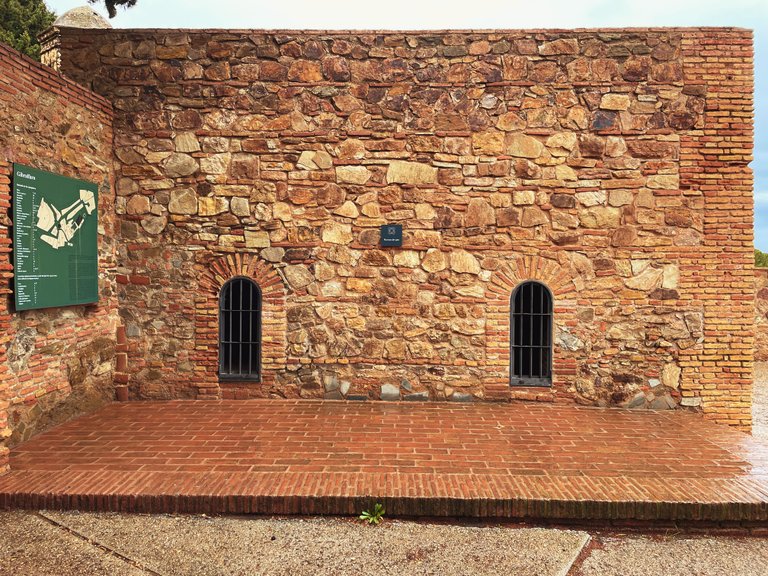



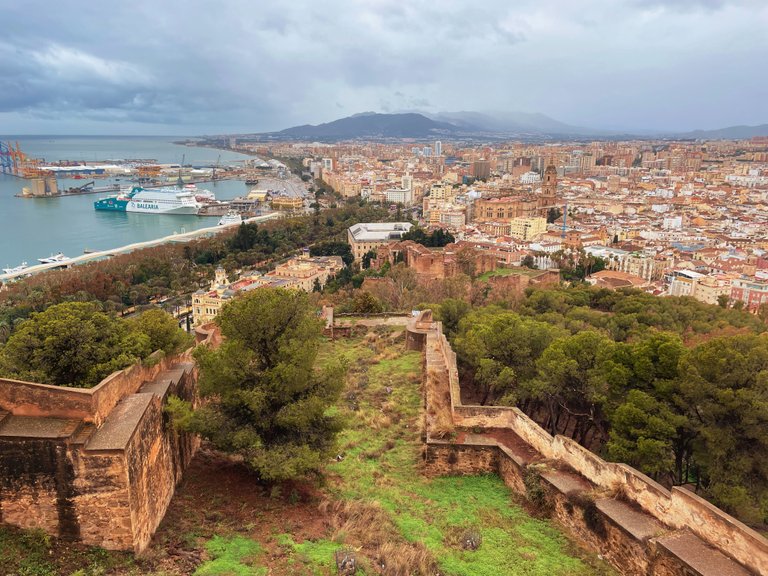






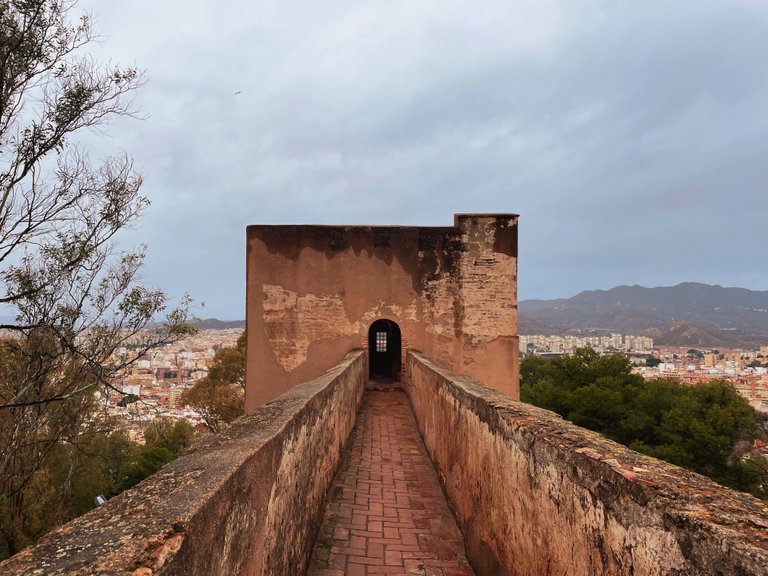
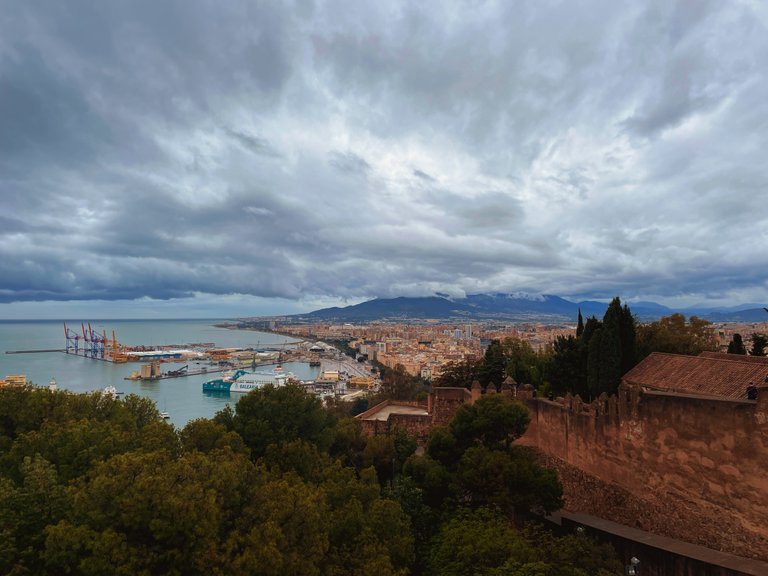
Alcazaba de Málaga
The Alcazaba de Málaga sits on the slope just below the Castillo de Gibralfaro. Originally a Phoenician fort attached to the old town, it was transformed into a fortified palace with massive double walls for the Moorish rulers of Málaga in the 11th century. Unlike the Castillo de Gibralfaro, the buildings of the Alcazaba showcase the Islamic Golden Age architecture, thanks in part to the significant efforts of Leopoldo Torres Balbás, a prominent Spanish architect and restorer.
With the fall of the Moors, the Alcazaba lost its strategic importance and transitioned into a city citadel. It endured severe damage during nearby naval battles and several earthquakes. As modern weaponry rendered such defensive structures obsolete, the Alcazaba briefly served as a military hospital before the once-famous gardens transformed into farmland. Restoration efforts began in the 1930s, and a century later, visitors can admire it in what is believed to be its genuine beauty.
Alcazaba de Málaga je bávalá Fénická pevnost, kterou Maurové v 11. století přestavěli na opevněný palác s masivní dvojitou hradbou. Je kousek pod Castillo de Gibralfaro a přiléhá ke starému městu. Palác je o poznání reprezentativnější než pevnost nad ním, jde o nádhernou ukázku architektury Zlatého věku islámu. A taky citlivého přístupu k památkám, který ve Španělsku razil mimo jiné architekt a restaurátor Leopoldo Torres Balbás.
Když byli Maurové ze Španělska vyhnáni, Alcazaba přišla o svůj strategický význam a sloužila hlavně jako městská citadela. Párkrát byla poničena při některé z blízkých námořních bitev a podepsalo se na ní i několik zemětřesení. A když podobné pevnosti přestaly mít kvůli rozvoji dělostřelectva význam, sloužila jako vojenský lazaret. Z kdysi proslulých zahrad se pak stala zemědělská půda. S rekonstrukcí se začalo ve třicátých letech minulého století, a tak se dnes můžete pokochat pohledem na Alcazaba ve stavu, který by měl odpovídat dobám její největší slávy.





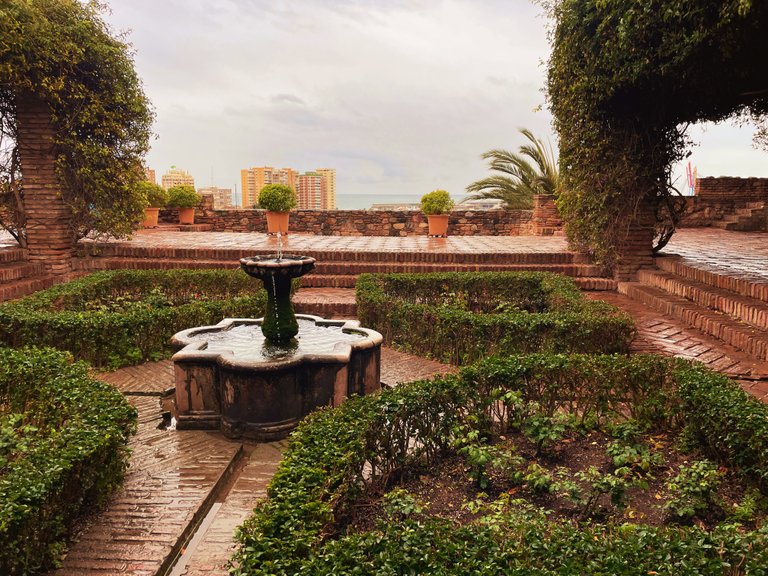


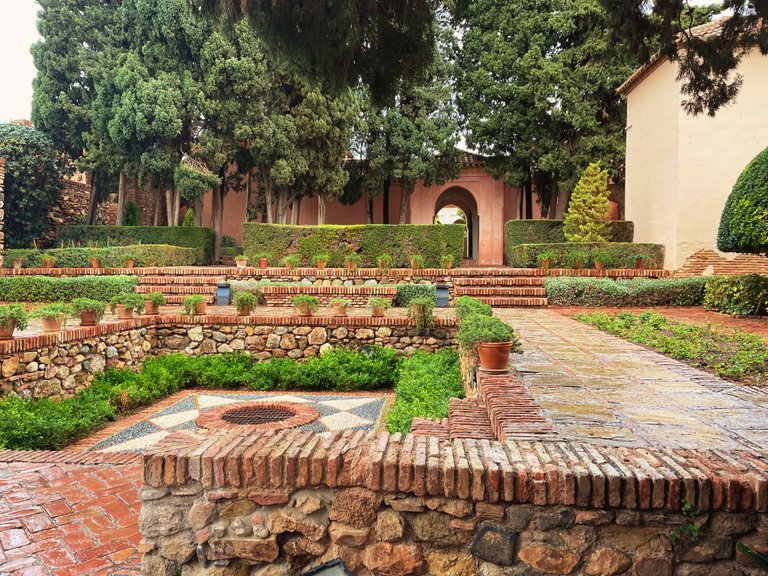






And with this alien-like flower that caught my attention, I bid you farewell for today. All that walking made us hungry, so naturally, we ventured out for some delightful Spanish tapas and wine. But I'll save those tasty tales for another time.
Touhle mimozemsky vypadající kytkou se s vámi pro dnešek rozloučím. Ze všeho toho chození nám vyhládlo, a tak jsme pochopitelně vyrazili na skvělé španělské tapas a víno. Ale o tom třeba zase někdy jindy.

Posted Using InLeo Alpha
Congratulations, your post has been added to Pinmapple! 🎉🥳🍍
Did you know you have your own profile map?
And every post has their own map too!
Want to have your post on the map too?
Awesome photos. The wet stones really make the colors pop.
That garden/castle in the hills above the city reminds me of a similar one they have in Barcelona (I don't recall its name) that I visited many years ago. But I guess the one in Barcelona was more garden than castle and this one is the opposite. btw, Do you happen to know what kind of plant the one in the last photo is? Never seen anything like that, very fascinating
Thank you, I've never considered myself a photographer ;) They are all mobile snapshots :)
The one above Barcelona is Montjuic I guess. This one is Moorish, though, so it's a completely different architectonical style inspired by Arabic tradition.
Nope, and I don't want to spoil the fantasy it's actually an extraterrestrial plant :)) If you want to have it identifiated, check https://www.inaturalist.org, it should recognize it.
But then don't tell me ;)
I like that approach!
Je to druh agáve, na Kanárech jsou skoro všude ;)
Ne! Tohle je druh mimozemské rostliny, který se sem náhodou dostal na podvozku létajícího talíře. A basta! ;)
https://en.wikipedia.org/wiki/Agave_attenuata
;)
Čistě k názvu. Věděl jsem, že Gibraltar znamená Tárikova hora. Tohle je převzaté z Wikipedie:
Název Gibraltar pochází z arabského slova جبل طارق romanizováno Džebel al-Tárik, doslova Tárikova hora, pojmenovaná podle maurského vojevůdce z 8. století Tárika ibn Zijáda. (Wikipedia)
Předpokládám tedy, že Gibralfaro bude znamenat "Hora s majákem". Napřed tu byl maják (Klidně ze starověku, od Kartáginců třeba. Já vím, že do Nového Kartága/Cartageny je to 400 km, ale na tomhle pobřeží se to po První punské válce Kartáginci doslova hemžilo...)
Pak přišli Arabové. Nakonec Španělé. A je pojmenováno.
Tohle k tomu říká španělská wiki:
Maják byl zřejmě od Féničanů, ale je fakt, že Málaga pak patřila Kartágu. Jestli se skutečně arabsky řekne hora s majákem gíbal al-faruh, netuším.
Říkáme oba totéž. Kdo založil Kartágo? Údajně královna Didó, dcera krále z Tyru, fénického to města. Kartágo údajně znamená Nový Tyros.
Pun, Féničan, Palestinec, Filištýn, Pelištejec, Kartáginec ... To jsou všechno varianty názvu jednoho národa/kmene.
This post has been manually curated by @steemflow from Indiaunited community. Join us on our Discord Server.
Do you know that you can earn a passive income by delegating to @indiaunited. We share more than 100 % of the curation rewards with the delegators in the form of IUC tokens. HP delegators and IUC token holders also get upto 20% additional vote weight.
Here are some handy links for delegations: 100HP, 250HP, 500HP, 1000HP.
100% of the rewards from this comment goes to the curator for their manual curation efforts. Please encourage the curator @steemflow by upvoting this comment and support the community by voting the posts made by @indiaunited.
Thanks, @steemflow ;)
No vida, gangsta racci to dotáhli na další cover :)
@tipu curate 2
Upvoted 👌 (Mana: 31/61) Liquid rewards.
Jsou to chlapci fotogeničtí :)
Díky.
How can I not want to walk through the Moorish fortress above the city with a view of the bullring, when I see such beautiful pictures 🙂
Cow figures in various colors in front of the favorite AleHop stores are the favorite plastic figures in Spanish cities.
When you mention seagulls as guardians of the fortress, I remember my profile picture from the Galata Tower, from my long-visited fb profile🙂
This entire structure is the living proof that things were build better many decades ago, I have always thought that life during those days might be more interesting than now but of course is just because would be a different experience for me, I guess people from those days would say the same about future times, some times the day by day, world conflicts and tech make life a bit too much, simplicity of those times could make things easier 😩🤷♂️
The secret behind is that there's hardly any piece of the original structure, they have all been replaced and reconstructed over the centuries ;)
The oldest bridge in Prague is Charles Bridge from 1357. It's a true historical gem. Yet it was torn down many times by flood, looking like that every now and then:
https://zpravy.aktualne.cz/domaci/obrazem-tak-vypadala-masivni-povoden-ktera-pred-131-let-strh/r~8ff10f44ede711ea842f0cc47ab5f122/r~cd16d27cede311eaa25cac1f6b220ee8/
The antique walls look great! The seagulls are wonderful.
Menos mal que las gaviotas os dejaron pasar 😁
They can be a bit aggressive actually, if there is a nest nearby they would not let you get close to it. So you met the famous Ale Hope cows with umbrellas when it is raining 😉
The only time we were in Malaga I was feeling so sick that we just saw the city centre and the park with the noisy parrots, had lunch and painkillers and continued our road trip. I wished I could climb the Castillo, it stayed as a wish to fulfil one day.
I guess it could last another couple of years, so you'll get a change to climb there ;)
Anyways, I'm likely leaving for Spain in mid-May, Madrid this time. Any chance you'd be arround? There's still the punky brewery to take you to for your first lesson of Instituto de Cervezologia ;)
Oh, clase en Instituto de Cervezología :D
I am afraid at the moment no first lesson will happen in May, as no chances for any trip to Madrid. Well, I have a day off... tomorrow 😁 but it's not mid-May :'
Well, yes, it is San Isidro, the city of Madrid patron sain ;)
Damn this place is epic... I lover how natural it is
I have heard about this city and this country that it is very beautiful and I also wish to visit there one day and see these natural sights with my own eyes.
Hey, what a beautiful walk. It's exquisite and to end it with wine and tapas... mmmmm, 🤤.
You can breathe freshness in those photos. I loved the landscapes too, I could stare at them for hours. And you, with all those details you provide, make this experience a delight. I even felt swords and fighting... men riding horses and sliding down the steep hillside. Wow... thank you so much for sharing. 🤗
I guess they preferred to stay on the hill and bombard ships and armies over riding into open battle from there, that's why they built it :))
I'm glad you liked the post :)
Well, anything can happen in the imagination. Notice that even cows use umbrellas hahaha....
And even the plastic ones ;)
😂 Of course, so it matches the umbrella
:)
Congratulations @godfish! You received a personal badge!
Wait until the end of Power Up Day to find out the size of your Power-Bee.
May the Hive Power be with you!
You can view your badges on your board and compare yourself to others in the Ranking
Check out our last posts: